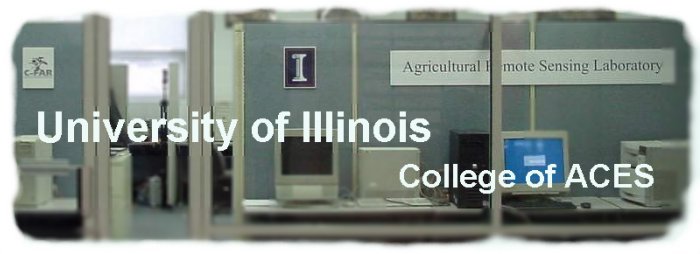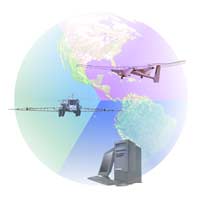|
|
|
|
|
|
|
|
|
|
|

![]()
The Mission
 The
mission of ILARS is to conduct applied research, work with industry and
government agencies to develop "real world" precision and
site-specific tools for the agriculture and natural resources
management.
Research conducted by the laboratory ranges from "on-farm" production
uses to large-scale agribusiness uses such as regional yield
estimations. The
laboratory is staffed with experts in the fields of crop science,
agriculture
engineering, extension, agriculture economics, geographic information
systems,
and remote sensing.
The
mission of ILARS is to conduct applied research, work with industry and
government agencies to develop "real world" precision and
site-specific tools for the agriculture and natural resources
management.
Research conducted by the laboratory ranges from "on-farm" production
uses to large-scale agribusiness uses such as regional yield
estimations. The
laboratory is staffed with experts in the fields of crop science,
agriculture
engineering, extension, agriculture economics, geographic information
systems,
and remote sensing.
Background
The era of commercial remote sensing for agriculture has finally
arrived.
Since the early days of the government run Landsat Satellite program,
remote
sensing experts have touted the benefits of remote sensing for crop
production
management. Unfortunately, the technology of these early
earth-observing
satellites was limited and the sensing system was not validated for
agriculture
use. Detecting exact locations of potential stresses within a field
were nearly
impossible. Quite frequently, the promises of useful applications of
remote
sensing to commercial
 agriculture
were never kept. To meet these challenges the University of Illinois'
College
of Agricultural, Consumer and Environmental Sciences is proposing to
create the
Illinois Laboratory for Agricultural Remote Sensing (ILARS).
agriculture
were never kept. To meet these challenges the University of Illinois'
College
of Agricultural, Consumer and Environmental Sciences is proposing to
create the
Illinois Laboratory for Agricultural Remote Sensing (ILARS).
![]() The
University of Illinois is well positioned to establish itself as a
leader in
the field of applied agricultural remote sensing. Many of the
components
necessary to achieve this goal are resident at the University and its
surrounding community. Many of our nation's top agriculture researchers
and
extension specialist have appointments with the University of Illinois'
specializing in the fields of crop sciences, agricultural engineering,
biotechnology, precision farming, and information systems.
Additionally, ACES
is aligning itself with the University's National Center for
Supercomputing
Applications (NCSA) to collaborate on such projects as using dynamic
models to
monitor agricultural runoff and using data mining and neural network
technology
to process high spatial and spectral remotely sensed data.
The
University of Illinois is well positioned to establish itself as a
leader in
the field of applied agricultural remote sensing. Many of the
components
necessary to achieve this goal are resident at the University and its
surrounding community. Many of our nation's top agriculture researchers
and
extension specialist have appointments with the University of Illinois'
specializing in the fields of crop sciences, agricultural engineering,
biotechnology, precision farming, and information systems.
Additionally, ACES
is aligning itself with the University's National Center for
Supercomputing
Applications (NCSA) to collaborate on such projects as using dynamic
models to
monitor agricultural runoff and using data mining and neural network
technology
to process high spatial and spectral remotely sensed data.
From an industry perspective several major agribusinesses have established research plots in and around the Champaign/Urbana area. These companies should be viewed as potential industry partners that could benefit from the use of remote sensing technology and would sponsor University research through ILARS. Many of these companies already have cooperative agreements and contracts with the University to fund cutting-edge agronomic, biotechnology, and engineering research.
The Function of the Laboratory
The focus of ILARS is toward applied research as opposed to basic
research.
The function of ILARS should be to engage U.S. agribusinesses in
applied remote
sensing research, designed to investigate potential business
opportunities and
to develop new product ideas and application prototypes for these
companies.
Emphasis should be placed on working with these businesses to
facilitate
commercializing the technology by focusing university research
capabilities on
industry requirements.

ILARS can take advantage of the existing relationship between ACES and NASA's Commercial Remote Sensing Program. In 1999, NASA began collaborating with University researchers through the Spectral Visions group that is located an office on the University's South Farms. Their close proximity provides the University with many benefits that include, training for graduate students via internships, access to NASA and commercially available imagery, collaboration with NASA remote sensing experts, etc.
The laboratory should introduce U.S. companies to spatial information and expose them to the most promising advanced remote sensing technologies. This will be accomplished by integrating university research activities with industry requirements to take advantage of advanced remote sensing technologies and applications. Finally the laboratory will expose University students to real-world problem-solving situations through partnership projects with U.S. companies.


